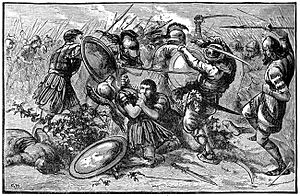Cunaxa
| Battle of Cunaxa | |||||||||
|---|---|---|---|---|---|---|---|---|---|
 19th Century English School depiction of the Battle of Cunaxa |
|||||||||
|
|||||||||
| Belligerents | |||||||||
| Cyrus the Younger |
|
||||||||
| Commanders and leaders | |||||||||
|
Cyrus the Younger † Clearchus Ariaeus |
Artaxerxes II Gobrias Tissaphernes |
||||||||
| Strength | |||||||||
| Large force of Persian soldiers 10,400 mercenary hoplites 2,500 mercenary light infantry and peltasts 1,000 Paphlagonian cavalry 600 bodyguard cavalry 20 scythed chariots |
40,000 | ||||||||
| Casualties and losses | |||||||||
| Minimal, death of Cyrus | Unknown | ||||||||
Coordinates: 33°19′29.48″N 44°04′46.33″E / 33.3248556°N 44.0795361°E
The Battle of Cunaxa was fought in 401 BC between Cyrus the Younger and his elder brother Arsaces, who had inherited the Persian throne as Artaxerxes II in 404 BC. The great battle of the revolt of Cyrus took place 70 km north of Babylon, at Cunaxa (Greek: ), on the left bank of the Euphrates. The main source is a Greek eyewitness and soldier, Xenophon.
Cyrus gathered an army of Greek mercenaries, consisting of 10,400 hoplites and 2,500 light infantry and peltasts, under the Spartan general Clearchus, and met Artaxerxes at Cunaxa. He also had a large force of levied troops under his second-in-command Ariaeus. The strength of the Achaemenid army was 40,000 men.
When Cyrus learned that his elder brother, the Great King, was approaching with his army, he drew up his army in battle array. He placed the Greek mercenaries on the right, near the river. In addition to this they were supported on their right by some cavalry, 1,000 strong, as was the tradition of battle order in that day. To the Greeks, this was the place of honor. Cyrus himself with 600 body guards was in the center, to the left of the Greek mercenaries - the place where Persian monarchs traditionally placed themselves in the order of battle. Cyrus' Asiatic troops were on the left flank.
...
Wikipedia
